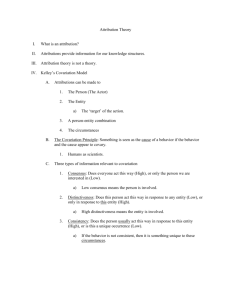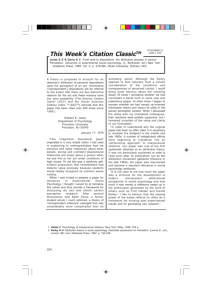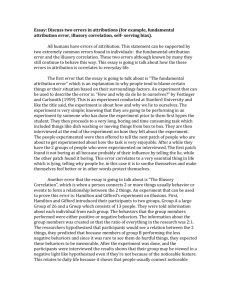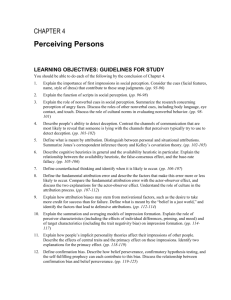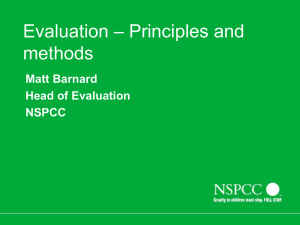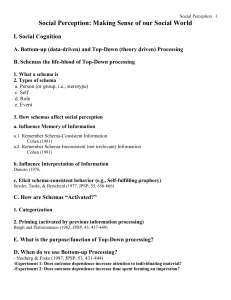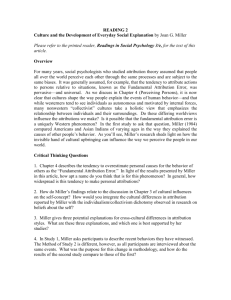Social Psychology
advertisement
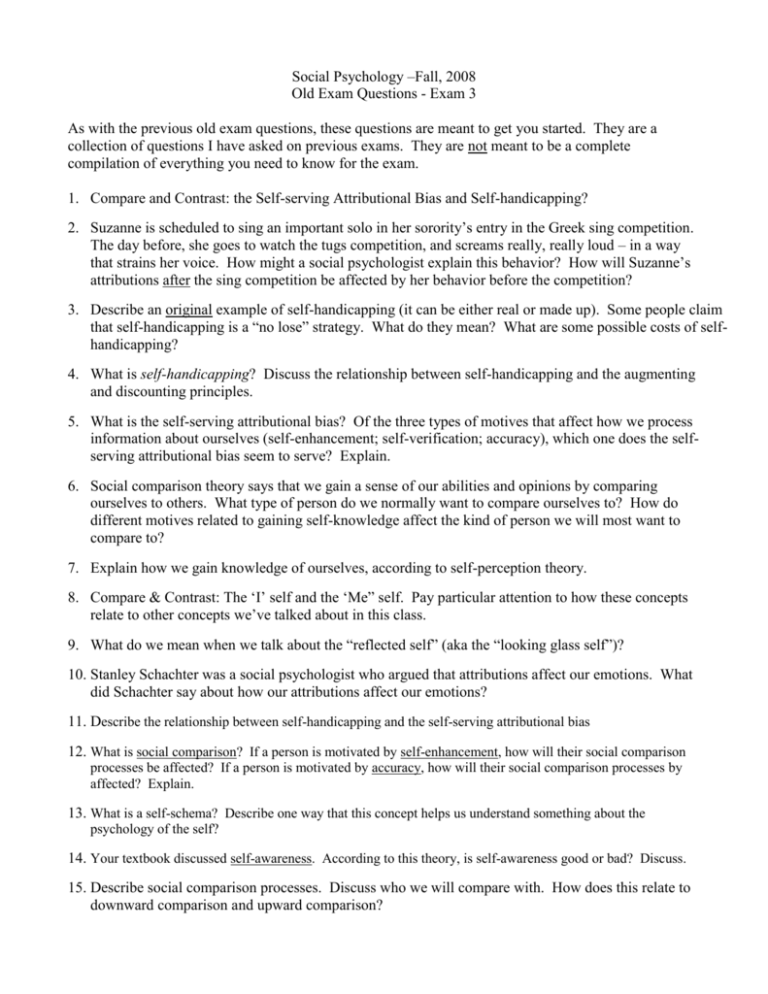
Social Psychology –Fall, 2008 Old Exam Questions - Exam 3 As with the previous old exam questions, these questions are meant to get you started. They are a collection of questions I have asked on previous exams. They are not meant to be a complete compilation of everything you need to know for the exam. 1. Compare and Contrast: the Self-serving Attributional Bias and Self-handicapping? 2. Suzanne is scheduled to sing an important solo in her sorority’s entry in the Greek sing competition. The day before, she goes to watch the tugs competition, and screams really, really loud – in a way that strains her voice. How might a social psychologist explain this behavior? How will Suzanne’s attributions after the sing competition be affected by her behavior before the competition? 3. Describe an original example of self-handicapping (it can be either real or made up). Some people claim that self-handicapping is a “no lose” strategy. What do they mean? What are some possible costs of selfhandicapping? 4. What is self-handicapping? Discuss the relationship between self-handicapping and the augmenting and discounting principles. 5. What is the self-serving attributional bias? Of the three types of motives that affect how we process information about ourselves (self-enhancement; self-verification; accuracy), which one does the selfserving attributional bias seem to serve? Explain. 6. Social comparison theory says that we gain a sense of our abilities and opinions by comparing ourselves to others. What type of person do we normally want to compare ourselves to? How do different motives related to gaining self-knowledge affect the kind of person we will most want to compare to? 7. Explain how we gain knowledge of ourselves, according to self-perception theory. 8. Compare & Contrast: The ‘I’ self and the ‘Me” self. Pay particular attention to how these concepts relate to other concepts we’ve talked about in this class. 9. What do we mean when we talk about the “reflected self” (aka the “looking glass self”)? 10. Stanley Schachter was a social psychologist who argued that attributions affect our emotions. What did Schachter say about how our attributions affect our emotions? 11. Describe the relationship between self-handicapping and the self-serving attributional bias 12. What is social comparison? If a person is motivated by self-enhancement, how will their social comparison processes be affected? If a person is motivated by accuracy, how will their social comparison processes by affected? Explain. 13. What is a self-schema? Describe one way that this concept helps us understand something about the psychology of the self? 14. Your textbook discussed self-awareness. According to this theory, is self-awareness good or bad? Discuss. 15. Describe social comparison processes. Discuss who we will compare with. How does this relate to downward comparison and upward comparison? 16. Briefly describe any three of the following: social comparison, self schema, the "me" self, the "looking-glass" self. (Discuss connections or similarities among the three you choose. ) 17. Discuss how the self or self-esteem can influence our judgements about the causes of behavior. 18. Describe self-handicapping. Discuss how this is related both to the discounting and augmenting principles, and to the self-serving attributional bias. 19. We have discussed the fact that there are two types of self presentation. Discuss the similarities and the differences between the two types of self-presentation. 20. Describe one type of strategic self-presentation, with an emphasis on what impression is trying to evoke, and how that impression serves the purpose of strategic self-presentation. If there is a particular problem that a self-presenter needs to watch out for with that type of self-presentation, be sure to briefly describe what it is. 21. Compare and contrast: Strategic self-presentation and non-strategic self-presentation. Define one type of strategic self-presentation that has been proposed by social psychologists, and give an example of non-strategic self-presentation that could happen in the real world. 22. Describe either the self-promoter’s paradox or the ingratiator’s dilemma. Include at least one specific behavior that can be used to try and overcome one of these problems (i.e., the one that you are describing). 23. What is self-verification? How does self-verification differ from self-enhancement? 24. Suppose you were to learn that someone threw marshmallows onto the field at a football game. Discuss what types of information Kelley’s covariation model of attribution would say are necessary in order to make a person attribution for the marshmallow throwing behavior. Be sure to give specific examples of each type of information that is appropriate to making a person attribution for the behavior. 25. Suppose you go on a first date with someone, and you go to dinner. Just as the waiter comes to take your order, your date starts screaming loudly. You are embarrassed, but you also want to figure out what it is that is causing this behavior. What information, according to Kelley’s Covariation Model of Attribution, would lead you to determine that there is something about the waiter that led to the screaming. Give specific examples of each type of information that you would need, and also make clear how each type of information corresponds to aspects of Kelley’s theory. 26. Suppose you are working at a crisis hotline, and someone calls worried that their friend is going crazy. When you ask them what makes them think that, they describe the friend acting in a seemingly bizarre way in a certain situation. You know that to decide that the person is crazy, you need to make a person attribution for the bizarre behavior. Kelley’s covariation theory of attribution would lead you to think you should ask three questions about the behavior to determine if a person attribution can be made. What are the three questions, and what are three possible answers that would lead to a person attribution? 27. Provide one original example of the augmenting principle in action. Be sure to describe how attributions would be affected by the augmenting principle. 28. Most people who have thought about how people make attributions have concentrated on whether a behavior is caused by the situation or the disposition. However, Bernard Weiner has studied the effects of other types of attributions, such as controllability, stability, and globality. Discuss at least one effect these dimensions have on reactions to either: people with a disability or stigma or difficulties in marriage. 29. What is a spontaneous trait inference. Describe one type of evidence which has supported the idea that people make these kinds of inferences. 30. Describe either the discounting or augmenting principles of attribution. Give an original example (i.e., one not taken from class or from your reading) of the rule in use. 31. It is said that and Kelley's covariation model and Jones’ Correspondent inference model are "rational baseline" theories of attribution. Describe what that means, and describe one example of a phenomenon of attribution that led to the realization that these models are not descriptive or predictive models. 32. Imagine you see someone go into a bar and order a drink called a "Skip and Go Naked." You know that the person comes from a very strict religious family where drinking alcohol is considered very immoral; you also know that this person is on a date with someone that they really like (and who is not really very religious). How might the "augmenting principle" or the "discounting principle" of attribution be applied in this situation? What attribution might you make for this behavior? (Be sure you explain what the augmenting and/or discounting principles [whichever is relevant to this situation] are). 33. Jones’ model of correspondent inference describes two kinds of information that affect whether or not a correspondent inference will be made. Describe these two types of information, and discuss why each is relevant to the making of a correspondent inference. 34. There is an old Joe Jackson song called “Is She Really Going Out With Him?” In which the singer wonders why his old girlfriend is going out with her new boyfriend. We all have times we remember where we can’t figure out why someone is going out with a particular other person. Discuss one such situation (it can be real or made up) from the perspective of Jones’ correspondent inference theory. Make up information that would allow you to make a correspondent inference for the person’s behavior. 35. Suppose you learn that a classmate is going to the library to study on a Friday night. Analyze this from the perspective of Correspondent Inference Theory. Can you make a correspondent inference for this behavior? What would that mean? 36. Suppose you met a new friend this semester, and that friend won $10,000 in the lottery last month. But, you also think that this friend has a crush on you. If your friend bought you a very expensive present for the holidays, how would the discounting or augmenting principle affect your attributions for his or her behavior? Explain 37. Make up an example of a situation where an observer applying Kelley’s covariation model would make a person-entity attribution. Be sure to describe enough information to allow the attribution to be determined by the observer, and to connect the information to the appropriate parts of Kelley’s model. 38. What is a correspondent inference? How does this relate to correspondence bias? 39. In class I mentioned that the fundamental attribution error may be responsible for some kinds of sexual harassment. Explain. 40. Discuss the effect of perceptual salience on attributions. How might this explain the actor-observer difference. 41. Compare and Contrast: the Self-serving Attributional Bias and Self-handicapping? 42. What is the actor-observer difference? Describe 2 possible explanations for why this happens. 43. One possible reason for the fundamental attribution error (FAE) involves the anchoring and adjustment heuristic. How could this explanation account for the FAE? 44. Kelley’s theory of attribution is called the covariation theory. The theory also says that there are 3 kinds of information that are relevant to making attributions. Using one of the kinds of information as an example, explain what Kelly means when he says attributions are related to covariation. 45. Define correspondent inference. What factors does Jones say should lead someone to make a correspondent inference? Why does it make sense to say that those factors are important for making a correspondent inference?
